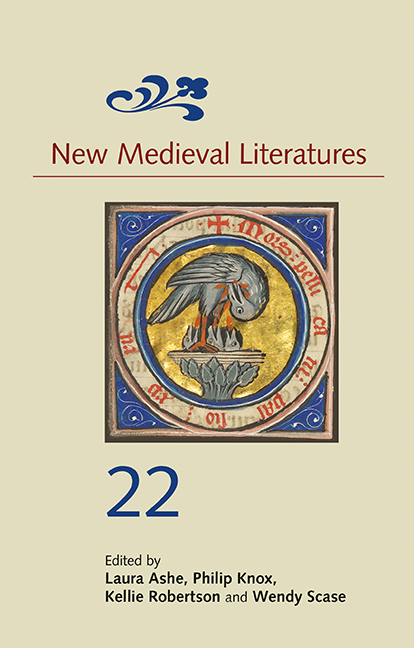Book contents
- Frontmatter
- Contents
- List of Illustrations
- List of Abbreviations
- 1 Touch and Movement in Chrétien de Troyes’s Chevalier de la Charrette
- 2 Cavernous Charisma: The Caves of the Patriarchs at Hebron
- 3 Lawman’s Vision of History: Sources and Figuration in the Brut
- 4 What the Mole Knows: Experience, Exempla, and Interspecies Dialogue in Albert the Great’s De animalibus
- 5 Demonic Prosthesis and the Walking Dead: The Materiality of Chaucer’s Green Yeoman
- 6 Learning to Live in Communities: Household Confession and Medieval Forms of Living
- 7 Alain Chartier’s Quadrilogue invectif and the Poetics of Political Community
- 8 Reginald Pecock’s moral philosophie, and Robert Holcot O.P.: Faith, Probabilism, and ‘Conscience’
- New Medieval Literatures Scholars of Colour Essay Prize
2 - Cavernous Charisma: The Caves of the Patriarchs at Hebron
Published online by Cambridge University Press: 26 May 2022
- Frontmatter
- Contents
- List of Illustrations
- List of Abbreviations
- 1 Touch and Movement in Chrétien de Troyes’s Chevalier de la Charrette
- 2 Cavernous Charisma: The Caves of the Patriarchs at Hebron
- 3 Lawman’s Vision of History: Sources and Figuration in the Brut
- 4 What the Mole Knows: Experience, Exempla, and Interspecies Dialogue in Albert the Great’s De animalibus
- 5 Demonic Prosthesis and the Walking Dead: The Materiality of Chaucer’s Green Yeoman
- 6 Learning to Live in Communities: Household Confession and Medieval Forms of Living
- 7 Alain Chartier’s Quadrilogue invectif and the Poetics of Political Community
- 8 Reginald Pecock’s moral philosophie, and Robert Holcot O.P.: Faith, Probabilism, and ‘Conscience’
- New Medieval Literatures Scholars of Colour Essay Prize
Summary
Benjamin of Tudela, the twelfth-century Spanish rabbi who narrated his travels throughout the Middle East, describes his visit to the Holy Land as especially treacherous. When he gets to Hebron and the Cave of the Patriarchs (Cave of Machpelah), he warns that Jewish pilgrims will not easily get to the tombs, because in order to prevent Jewish travelers from getting to the site, Christian rulers had built a church atop the mosque that had housed the tombs. But, he adds, the tombs inside the Church are false anyway. The real tombs can be found by especially intrepid pilgrims who are willing to descend into the earth to search for them deep underground. There, in a deep sub-cavern, the tombs stand, with Hebrew inscriptions to verify their authenticity.
In this essay, I focus on these underground tombs to think about subterranean excavation as a method for reading spaces that accommodate multiple languages, cultures, and rituals. What happens to our understanding of a ‘global Middle Ages’ when we move underground? The methods by which scholars navigate a global Middle Ages are often horizontally oriented, moving across geopolitical boundaries to trace transcultural networks of goods, epistemologies, and vocabularies. As Geraldine Heng argues, articulating a global Middle Ages requires ‘transhumanities work’ to draw upon ‘points of viewing gathered multi-locationally across the planet’. Likewise, Candace Barrington and Louise D’Arcens define a global Middle Ages as ‘a period of thriving intercultural exchange’, and they argue that thinking about globalism in the premodern period requires looking between or among different places, rituals, cultures, and/or languages. Such horizontal analysis – focusing on ‘trans’ or ‘inter’ modes of reading – has crucially helped extract medieval studies from its artificial and anachronistic disciplinary, linguistic, and geographical isolations. However, rather than traverse the globe, in this essay I stay in one place. By focusing on the caves in Hebron, a sacred pilgrimage site for Christians, Muslims, and Jews alike, I suggest the subterranean as a complementary mode of global analysis, one that drills downward instead of moving across the world.
As the burial site of the Patriarchs and Matriarchs, the Hebron caves are variegated spaces of cultural experience, and they work at surface and depth registers at the same time. Indeed, the Caves of the Patriarchs demand a modular hermeneutics that must flexibly navigate so-called surface and symptomatic interpretive practices.
- Type
- Chapter
- Information
- New Medieval Literatures 22 , pp. 31 - 54Publisher: Boydell & BrewerPrint publication year: 2022



